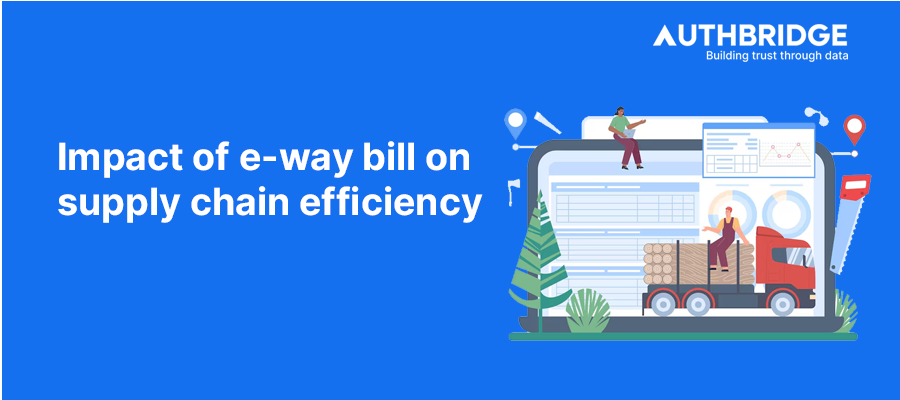E-Way Bill And Supply Chain Efficiency: Maximizing Benefits And Navigating Challenges

1. Introduction to E-Way Bill and Supply Chain Efficiency
Overview of E-Way Bill System
The E-Way Bill is an electronic documentation system for tracking the movement of goods under the GST regime, mandatory for both inter-state and intra-state transportations exceeding a certain value threshold. It's designed to facilitate faster movement of goods by reducing paperwork and improving compliance with GST regulations.
Significance in Supply Chain Management
The introduction of the E-Way Bill system marks a significant step towards digitalization in supply chain management, aiming to enhance efficiency, reduce transit times, and ensure transparency in the movement of goods across India.
2. Enhancing Transparency and Traceability
Real-Time Tracking of Goods
The E-Way Bill enables real-time tracking of goods, allowing businesses and tax authorities to have up-to-date information on the movement of goods, thereby enhancing transparency and aiding in better logistics planning.
Improved Record-Keeping and Compliance
With digital record-keeping, the E-Way Bill system simplifies compliance, reduces the risk of errors, and ensures that businesses maintain accurate records of their transactions, facilitating smoother audits and inspections.
3. Reducing Transit Times and Costs
Minimizing Delays at Checkpoints
By streamlining the documentation process, the E-Way Bill system minimizes delays at checkpoints, leading to faster transit times and more predictable delivery schedules.
Lowering Logistics Costs
Reduced transit times and improved operational efficiency contribute to lowering overall logistics costs, making supply chains more cost-effective and competitive.
4. Challenges in Implementation and Operation
Implementing the E-Way Bill system has not been without its hurdles. These challenges have required attention and action to ensure the system's smooth operation and the continued efficiency of the supply chain.
Technical Glitches and System Overloads
The initial rollout of the E-Way Bill system encountered technical issues, including server downtimes and glitches, which temporarily hindered the ability of businesses to generate or manage E-Way Bills effectively.
Training and Adaptation for Stakeholders
Ensuring all participants in the supply chain are familiar with the E-Way Bill system's requirements has been a significant undertaking, particularly for smaller businesses and transporters less accustomed to digital processes.
Data Table: Implementation Challenges
Challenge | Impact | Solutions |
Technical Glitches | Delayed E-Way Bill generation | Enhancements in IT infrastructure |
Training Needs | Inconsistent usage among stakeholders | Comprehensive training programs |
5. Impact on Small and Medium Enterprises (SMEs)
SMEs, while standing to gain significantly from the E-Way Bill system, face unique challenges in adapting to and complying with its requirements.
Opportunities for Efficiency Gains
The streamlined process for moving goods has the potential to significantly benefit SMEs by reducing logistics costs and improving delivery times.
Challenges in Compliance and Adaptation
The digital nature of the E-Way Bill system poses adaptation challenges for SMEs, particularly those with limited access to technology or digital literacy.
Data Table: SME Impact
Aspect | Opportunity | Challenge |
Efficiency Gains | Reduced logistics costs | Adapting to digital processes |
Compliance | Improved GST compliance | Understanding complex regulations |
6. Future Trends in E-Way Bill System and Supply Chain Management
The E-Way Bill system is expected to evolve, driven by technological advancements and regulatory changes, further impacting supply chain management.
Technological Advancements
Innovations such as AI, IoT, and blockchain are anticipated to integrate with the E-Way Bill system, offering new levels of efficiency, accuracy, and security.
Regulatory Changes and Their Implications
Ongoing updates to GST regulations and the E-Way Bill framework will necessitate continuous adaptation by businesses to remain compliant and competitive.
Data Table: Future Trends
Trend | Description | Expected Impact |
Technological Innovations | Integration of AI, IoT, and blockchain | Enhanced efficiency and security |
Regulatory Changes | Updates to GST and E-Way Bill rules | Need for continuous adaptation |
Conclusion
The E-Way Bill system represents a significant step forward in the digitalization of supply chain management, offering benefits such as improved efficiency, transparency, and compliance. While challenges remain, particularly for SMEs and in the face of technical issues, the system's overall impact on the supply chain has been positive. Looking ahead, technological advancements and regulatory changes will continue to shape the E-Way Bill landscape, promising even greater benefits for supply chain management. Businesses, especially SMEs, will need to stay informed and adaptable to leverage these developments fully, ensuring their continued growth and success in a dynamic market environment.
Category

Abhinandan Banerjee
(Associate Manager - Marketing)
Abhinandan is a dynamic Product and Content Marketer, boasting over seven years of experience in crafting impactful marketing strategies across diverse environments. Known for his strategic insights, he propels digital growth and boosts brand visibility by transforming complex ideas into compelling content that inspires action.



